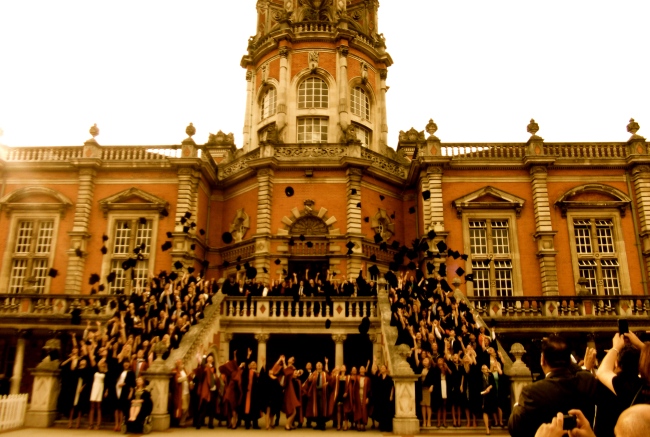Well, that’s that. The end has been and gone. I am now a graduate of Royal Holloway, University of London.
Sheesh. I know it’s a cliche, but where did the time go? Seriously, where did it go? I don’t feel grown up enough to have a whole three letters after my name! Only a week and a bit ago, I left campus for the last time. Saying goodbye to Medicine, to happy memories in Tuke and Reid, to times spent rushing through Canada Copse in the rain to a 9am lecture, or times spent stumbling through Canada Copse after a drunken night out at a Monkey’s Mondays (oh, Monkey’s Mondays…), to afternoons spent lazing in the quad with Pimm’s, or in Crosslands on a gloomy winter’s evening, to hours spent trying to stay awake in the Windsor Auditorium or trying to get comfortable in MLT, to horrendously early mornings putting milk out at the College Shop, to campus tours in the sun with enthusiastic parents (and not-so-enthusiastic prospective students…), to times spent making that long walk down to Kingswood to play a few games of squash, or evenings with the debating lot getting raucous and ripping each other’s arguments apart, to late nights writing stats reports and lab reports and trawling through journals for a decent reference or two, to walking up that path to Founder’s in the spring when the daffodils are out and realising that there’s nowhere else in the whole world that I’d rather be…
Yeah, I’m not sure I’m quite ready to let go yet. It doesn’t even seem real yet, in fact. Though graduation was lovely- here, look at this photo. Isn’t it lovely?
Yes, lovely. Lovely day. Very hot in those ruddy gowns that, as our Principal said, clearly weren’t designed for women- or anyone with shoulders less than 6ft wide. And someone stole my mortarboard after we threw them in the air, so I ended up with an extra small one that I had to balance atop my head for the remainder of the afternoon. But yes, lovely. I very much enjoyed chatting to the lecturers one last time (though I ended up popping to a prof’s leaving do at a pub the following week anyway, so my many emotional goodbyes subsequently seemed a bit redundant). And my parents had a blast. Overall, it couldn’t have gone much better.
But when I look at photos of graduation, as lovely as they are, it seems odd that they’re mine- that this was my graduation, that the psychology cohort I’ve grown to love over these past three years came together that afternoon to celebrate what is, admittedly, a pretty big achievement. It’s weird that it’s happened already. You see photos of friends in higher years graduating before you, you have an idea of what’s going to happen, and you know that one day, that’s going to be you. And yet, when it happens, despite months of expectation, years of anticipating that unavoidable, harshly inevitable day, the day that’s been floating around in the back of your mind even since you were a fresher- yet, when it happens, it doesn’t seem real.
Eh, I’ll get over it. We all do.
Now it’s onto the next thing: a master’s in a different city, with different people. A different vibe entirely. However, one thing I am particularly glad about regarding my undergrad years (aside from the degree itself, of course) is just how many wonderful people I managed to meet, and especially how many of those people I’ll be keeping in touch with. Yes, there’s a sense of ‘onwards and upwards’ now, and I might not be going back to the campus at Holloway any time soon, but there’s a lot I’ll be taking with me from that wonderful, wonderful place.
